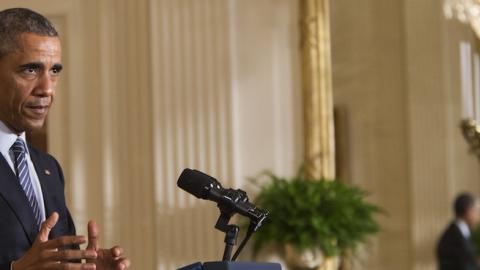The late great comedian Milton Berle, when introduced to an enthusiastically applauding audience, would hold up his left hand in a modest gesture as if to say thank you but that’s enough, and with his right hand held at waist level encouraged the audience to even wilder applause. President Obama has just accomplished a similar feat. With one hand he has delivered his Clean Power Plan, designed to reduce the use of our own resources of fossil fuels. With the other he has signed off on a deal with Iran that will set the Islamic Republic on the path to dumping between four and five million barrels of its crude oil on world markets every day, further lowering the price of oil and thereby encouraging its consumption. These deals, taken together, replace emissions from U.S. fossil fuel production and use with emissions from increased use of Iranian oil. In effect, Obama has transferred pollution permits from our producers to the Revolutionary Guard that controls Iran’s oil industry.
The Clean Power Plan for Existing Power Plants (CPP) and its accompanying regulations, all 2,691 pages, is the largest exercise in central planning, outside of Cuba and North Korea, since the collapse of the Soviet Union. It calls for a reduction of 32 percent from 2005 levels in power-plant carbon emissions by 2030. If you agree with the president that climate change is a huge threat to our future, a greater threat than ISIL or Islamic terrorism or Iran’s mullahs, and that American reductions will affect total global emissions, setting an emissions-reduction target makes sense. But the CPP goes further, and sets the specific means by which that is to be accomplished.
Natural gas use can increase by only 22 percent by 2022 from 2012 levels and thereafter increase at an annual rate of only 5 percent, and new natural gas plants that replace coal will not count as having reduced emissions. A rejiggering of EPA models resulted in a major increase in the role initially accorded renewables and in our future reliance on the sun and the wind, the one which sometimes shines, the other which sometimes blows, most usually in places far from the existing super-reliable electricity grid. Never mind that both continue to require massive subsidies, which the renewable industry heatedly denies while at the same time coolly lobbying for their continuation.
Sad to say, conservative opponents of such central planning have brought this state of affairs on themselves. Obama originally proposed a cap and trade plan, which relied on the sort of market forces that Republicans had introduced to make the application of the Clean Air Act more efficient. Once the courts ruled that that act gives the EPA authority to regulate carbon emissions from power plants, conservative opposition to market mechanisms has allowed Obama to rely on regulation to achieve emissions reductions. Rather like Bre’r Rabbit, who disingenuously pleaded with Bre’r Fox not to throw him into the briar patch, Obama pleaded with Congress not to force him to rely on regulation, shrugged when turned down, and fled into the regulatory thicket in which he and his progressive allies are more comfortable than in a marketplace.
Conservatives now are consoling themselves with the thought that when the president goes to Paris in December and presents his plan, he will label it a “commitment” because he dare not submit it to Congress for the approval that a treaty requires. That would allow the next president, assuming it is a Republican every bit as tough as the various primary candidates claim to be, to add to those day-one lists candidates like to recite a notice to the world that the “commitment” of the previous president counts for nothing. That would be neither easy nor wise, since that new president would probably also have pledged to make America’s commitments matter again—no more crossed red lines, no more abandonment of allies.
Which seems to have reduced opponents of the plan to wishful thinking. Surely the courts will disallow this grab for control of the nation’s energy sector. Perhaps, but there are “definitely novel issues in this case,” according to Tim Profeta, director of Duke University’s environmental policy institute, making the courts’ decisions difficult to predict. Surely the EPA will honor its pledge to allow the states to devise their own plans to meet its emission-reduction targets. But that pledge is to permit states to propose implementation plans that are subject to EPA approval. To believe that approval would be granted to plans that rely heavily on market-based steps to reduce emissions requires an act of faith that rivals the pope’s in the rectitude of his attacks on capitalism. This, after all, is an agency that is committed to the slaughter of the coal industry and has turned on our sensationally productive frackers; that refused to consider the cost of its mercury regulations until forced to do so by the courts and is now proposing to replace power generation with renewables that cost more than twice as much; that counts as a benefit of the new regulations the value of the lives it claims to have already saved by its ozone and mercury regulations; and, unlike any other regulatory agency, is run by a director who has refused repeated requests from the House Science Committee to make available the raw data on which EPA regulations ultimately rely.
It is, of course, possible that the 41 states that are attempting to coordinate their responses so as to minimize total compliance costs will win EPA approval, but this is to rely on the reasonableness of an agency that long ago surrendered its reputation for objectivity and independence from the administration. Its director, Gina McCarthy, has testified that she has “an obligation to the planet”; that the value of EPA rules is not measured in how much they reduce emissions but “in showing strong domestic action which can actually trigger global action to address what is necessary action”; and that she doesn’t “need the raw data in order to develop science. That’s not how it’s done.” My guess is that how it is done is with a phone call to the White House.
Conservatives have little time and much work to do to lay the basis for walking away from Obama’s plan while at the same time retaining the commitment to its goals as enunciated by him in Paris. Our global partners must be reassured that a Republican president will not repudiate the president’s goals, but will substitute more efficient ways of meeting them. Assuming, of course, that other nations are keeping their promises so that the American effort is one of many contributors to reducing global emissions, rather than a futile effort with no significant impact.
Fortunately there is a method at hand to accomplish the twin goals of establishing that American commitments mean something while at the same time retaining our reservations about the climate-change thesis: tax reform. With two major tax inversions announced on August 5—American companies merging with an overseas company and making its foreign headquarters the corporate home for tax purposes in order to flee the American tax system—the pressure for reform is mounting. Add to that the conviction by most conservatives that raising the minimum wage or jiggering the overtime pay regulations, the market interventions favored by Obama and his progressives, will do little to help the beleaguered middle class or to reduce income inequality.
But reducing the tax burden on lower- and middle-class workers just might address what ails them—the failure of their real take-home pay to rise. That can be accomplished by imposing a tax on carbon and using the proceeds to reduce payroll taxes on workers with incomes below some selected level. Conservatives in Congress who do not believe the Earth is about to cook can nonetheless vote for this tax with a clear conscience—they will have done it to generate revenue to help solve problems all Republican presidential wannabees claim they want to solve. If they do so in time to make it part of a tax reform effort, and Obama vetoes it, so be it: The world will know that America under a Republican will follow a different path but to the same end promised by his predecessor. And if Obama plays the pope card in support of his regulatory approach, conservatives who believe in markets can counter with a letter to the president from 170 evangelicals—pastors, professors, and others—supporting “a market-based approach, such as a revenue-neutral carbon tax swap that cuts other taxes.” Deciding which approach is more pleasing to the Ultimate Authority is best left to other experts.
Better ideas are more than welcome.
















